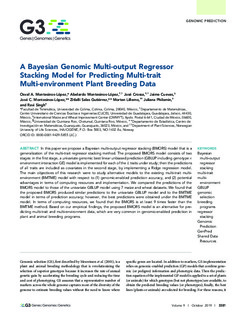| dc.contributor.author | Montesinos-Lopez, Osval A. | |
| dc.contributor.author | Montesinos-Lopez, Abelardo | |
| dc.contributor.author | Crossa, Jose | |
| dc.contributor.author | Cuevas, Jaime | |
| dc.contributor.author | Montesinos-Lopez, Jose C. | |
| dc.contributor.author | Zitlalli, Salas Gutierrez | |
| dc.contributor.author | Lillemo, Morten | |
| dc.contributor.author | Philomin, Juliana | |
| dc.contributor.author | Singh, Ravi P. | |
| dc.date.accessioned | 2019-12-03T08:02:35Z | |
| dc.date.available | 2019-12-03T08:02:35Z | |
| dc.date.created | 2019-11-29T12:19:17Z | |
| dc.date.issued | 2019 | |
| dc.identifier.citation | G3: Genes, Genomes, Genetics. 2019, 9 (10), 3381-3393. | |
| dc.identifier.issn | 2160-1836 | |
| dc.identifier.uri | http://hdl.handle.net/11250/2631366 | |
| dc.description.abstract | In this paper we propose a Bayesian multi-output regressor stacking (BMORS) model that is a generalization of the multi-trait regressor stacking method. The proposed BMORS model consists of two stages: in the first stage, a univariate genomic best linear unbiased prediction (GBLUP including genotype x environment interaction GE) model is implemented for each of the L traits under study; then the predictions of all traits are included as covariates in the second stage, by implementing a Ridge regression model. The main objectives of this research were to study alternative models to the existing multi-trait multi-environment (BMTME) model with respect to (1) genomic-enabled prediction accuracy, and (2) potential advantages in terms of computing resources and implementation. We compared the predictions of the BMORS model to those of the univariate GBLUP model using 7 maize and wheat datasets. We found that the proposed BMORS produced similar predictions to the univariate GBLUP model and to the BMTME model in terms of prediction accuracy; however, the best predictions were obtained under the BMTME model. In terms of computing resources, we found that the BMORS is at least 9 times faster than the BMTME method. Based on our empirical findings, the proposed BMORS model is an alternative for predicting multi-trait and multi-environment data, which are very common in genomic-enabled prediction in plant and animal breeding programs. | |
| dc.description.abstract | A Bayesian genomic multi-output regressor stacking model for predicting multi-trait multi-environment plant breeding data | |
| dc.language.iso | eng | |
| dc.title | A Bayesian genomic multi-output regressor stacking model for predicting multi-trait multi-environment plant breeding data | |
| dc.type | Peer reviewed | |
| dc.type | Journal article | |
| dc.description.version | publishedVersion | |
| dc.source.pagenumber | 3381-3393 | |
| dc.source.volume | 9 | |
| dc.source.journal | G3: Genes, Genomes, Genetics | |
| dc.source.issue | 10 | |
| dc.identifier.doi | 10.1534/g3.119.400336 | |
| dc.identifier.cristin | 1754455 | |
| dc.relation.project | Norges forskningsråd: 267806 | |
| cristin.unitcode | 192,10,2,0 | |
| cristin.unitname | Institutt for plantevitenskap | |
| cristin.ispublished | true | |
| cristin.fulltext | original | |
| cristin.qualitycode | 1 | |
